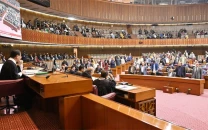Afghanistan: what next?
An impending disaster if a comprehensive agreement is not reached

“It is going to be hard to meet the May 1 deadline in terms of tactical reasons. It’s hard to get those troops out. We will leave, the question is when we leave.” — US President Joseph Biden.
If the Biden administration wants to review Doha agreement, the Taliban are vehemently against revising the timeline of May 1 for the withdrawal of American forces from Afghanistan and have warned of serious consequences if Washington reneges on its commitment. As a result, one can anticipate a standoff as far as the US and Taliban are concerned.
There is no other country in the modern history which is a cause for enormous regional and international concern as Afghanistan. A chain of events in the last two weeks or so tend to trigger multilateral efforts to save Afghanistan from an impending disaster if a comprehensive agreement is not reached over the inter and intra-Afghan peace process before the deadline of final withdrawal of American forces from that war-torn country.
If a new version of peace plan mentioned in a letter written to the Afghan President Ashraf Ghani by US Secretary of State Antony Blinken and the recent visit of American Defense Secretary Lyold Austin to Kabul reflect impatience on the part of the Biden administration to wrap up his country’s longest war, but on its own terms, the Taliban and the Kabul regime are in an opposite direction as far as giving a new shape to the Doha agreement is concerned. Will the Kabul regime agree on an inclusive interim government in Afghanistan; and if not, will it be in a position to oppose such an American move? Will Taliban agree to power sharing for 90 days leading to a comprehensive peace accord? To what extent a multi-stakeholder approach will give an impetus to the Afghan peace process and how can one expect Afghans to manage conflicts on their own particularly in the absence of foreign forces?
Getting out from a devil and deep blue sea like situation in Afghanistan is the need of the hour. More than 40 years of armed conflicts, wars and civil war in Afghanistan destroyed three generations of that country and even now, there seems to be a lack of political will, trust and seriousness on the part of Afghan stakeholders to establish peace in their country. Failure of the Afghans to put their own house in order since the overthrow of monarchy in July 1973 led to the foreign intervention and occupation of Soviet and American forces. If Afghanistan became a hub of terrorism and Taliban-Al Qaeda nexus culminated into attacks on twin towers in New York and Pentagon in Washington DC, the fault not only lay inside Afghanistan, but the international community was also to blame as it abandoned the country after the Soviet military withdrawal in February 1989. Now, it is quite clear to the United States, the West and all the neighbours of Afghanistan that without ensuring a smooth power structure and a stable political system, the vacuum from an American/NATO withdrawal may result into fresh outbreak of violence.
Currently, there are around 2,500 US forces in Afghanistan down from 100,000 in 2009. Furthermore, in order to exert pressure on Taliban and other violent groups in Afghanistan, it was decided on January 1, 2015 to establish the NATO-led Resolute Support Mission (RSM) following the completion of the International Security Assistance Force (ISAF) which was established after the Taliban regime had been toppled in December 2001. After reaching an agreement with the Kabul regime, the RSM was given the mandate to operate in Kabul, Bagram, Mazar-e-Sharif, Herat, Kandahar and Laghman areas of Afghanistan. The 10,000-strong RSM — comprising personnel from 36 NATO member countries and their allies — cannot be an alternate to the US combat troops but can certainly provide a cushion to the Kabul regime provided the warning given by Antony Blinken — that in the event of American withdrawal Taliban may take over large parts of Afghanistan — doesn’t come true.
In order to prevent a nightmarish scenario in the event of a total American military withdrawal from Afghanistan, the Biden administration came up with an innovative idea to take on board the United Nations, Turkey, Russia, Iran, Pakistan and India as a multi-stakeholder approach for peace in Afghanistan. The US supported Moscow conference on Afghanistan and urged Turkey to take a similar move by inviting different Afghan and foreign stakeholders for an effective brainstorming session to help prevent the surge of violence and armed conflicts in the event of the pullout of the American forces by May 1. Yet, the Biden administration does subscribe to concerns and alarms raised by the Department of Defense and some circles in the Congress that the US military withdrawal from Afghanistan by following the deadline mentioned in Doha accord may create a dangerous void which may be filled in by Taliban and other Islamist extremist groups including Al Qaeda. But is it not too late to seek the involvement of the UN for peace in Afghanistan? Unfortunately, after ditching Afghanistan following the Soviet military withdrawal, the US didn’t either encourage the UN to play a vibrant role for preventing the surge of conflict among different Mujahedeen groups. The ramifications of such an imprudent policy still haunt Afghanistan and the world.
What next in Afghanistan needs to be analysed by examining three major realities.
First, ambivalence, mistrust, suspicion and lack of political will on the part of Afghan stakeholders, particularly Taliban and their political opponents. Taliban signed an accord with the US in Doha in February 2020 but failed to reach an agreement with their Afghan counterparts. Now, with hardly six weeks left for the expiry of the pullout deadline, the Biden administration is coming up with two different alternates. On the one hand, as stated by Lyold Austin, American Defense Secretary in Kabul, the possibility of reviewing the May 1 withdrawal deadline exists while on the other hand, it still wants to adhere to that deadline but without assuring the Kabul regime and its allies how to handle the situation in case violence surges and Taliban occupy vast territories. Taliban have rejected the proposal of President Ghani to hold early presidential elections because such an arrangement will further complicate the crisis.
Second, there is more talk and rhetoric than the pursuance of practical measures for what the US calls taking ‘responsible measures’ for peace in Afghanistan. The Moscow conference, the ‘Heart of Asia’ conference’ in Dushanbe under the ‘Istanbul process’ on Afghanistan and subsequent events related to inter and intra-Afghan dialogue may not yield positive results unless a multi-stakeholder approach is applied by the parties concerned. Unless effective ceasefire is agreed upon by the Afghan government, the Taliban and other warring groups, efforts made outside and inside Afghanistan for a responsible peace process cannot yield positive results.
Third, Afghanistan would have been better off and resolved its contentious issues had its leadership, whether in the government or in the opposition, been visionary and focused on ameliorating socio-economic conditions of the people. What next in Afghanistan depends on how local and external stakeholders express their readiness and seriousness in taking the Afghan peace process to its logical conclusion.
Published in The Express Tribune, March 28th, 2021.
Like Business on Facebook, follow @TribuneBiz on Twitter to stay informed and join in the conversation.













COMMENTS
Comments are moderated and generally will be posted if they are on-topic and not abusive.
For more information, please see our Comments FAQ